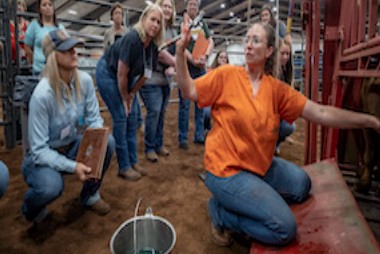
Senior Farm and Ranch Broadcaster, Ron Hays, is featuring comments from Farm Director KC Sheperd’s visit with Dr. Rosslyn Biggs of OSU talking about the veterinarian shortage in rural areas across the country.
When it comes to the reason for the veterinarian shortage, Biggs said there is not one simple answer to the question.
“We have recently had some statistics from the American Veterinary Medical Association,” Biggs said. “This is across all practice types so companion animal, to large animal and everything in between. Something happened in the pandemic where we went from about 3.5 jobs available for every veterinarian looking to now 12.5 jobs for every veterinarian looking which is amplifying our need in the rural space.”
The underserved areas, Biggs said are defined as areas with farmers and ranchers that need services, but the demand in the particular geographic region cannot support a stand-along veterinarian for just a handful of counties.
Biggs also talked about the new Integrated Beef Cattle Program that offers intervention strategies for rural sustainability by expanding veterinary skills and knowledge of herd health, food nutrition, forage management, reproductive management, and other common needs of beef producers.
“We were very fortunate to receive a USDA grant first of all to start this program and we have 20 beef cattle veterinarians in Oklahoma sitting alongside in the same classroom as 20 current veterinary students,” Biggs said. “So, what they started out with was leadership, communication, education, curriculum, and building those relationships and building that network.”
The Integrated Beef Cattle Program is supported by the USDA, Biggs said, as well as through our other sponsors such as the Oklahoma Cattlemen’s Association and the Oklahoma Department of Agriculture.
Biggs recommends that current rural vets mentor relationships with vet students and invite them to shadow, for example, to encourage them to practice rural.
“Taking a little bit of time to help develop the next generation, inviting them into the practice, showing them what it’s all about and getting them some experience is a great first step,” Biggs said.
As community members, Biggs said to establish relationships with your rural vet sooner than later.
“That 2 a.m. calving call is not when you want to develop the relationship,” Biggs said. “You want to support them, and you want to have those conversations because in my mind, I am a veterinarian and I am a member of your team because I want you to be in business for a very long time and I want you to be profitable and so supporting each other is really key.”
Biggs said she is confident in the skills of the students enrolled in the OSU College of Veterinary Medicine.
“We have a tremendous advantage here in Oklahoma with our veterinary school and we turn out year after year practice ready veterinarians that I will put toe-to-toe with a graduate from any other veterinary school,” Biggs said. “We certainly have our challenges at the school, but I am encouraged with the leadership from the university standpoint as well at the college standpoint that we are making strides in those areas and continuing to turn out great veterinarians.”
With her space being in the large animal sector, Biggs said she likes to encourage students to take that path, but she would like to see successful veterinarians wherever they chose to land.
Click the LISTEN BAR below to hear more from Dr. Rosslyn Biggs on the rural vet shortage across the country.
The Beef Buzz is a regular feature heard on radio stations around the region on the Radio Oklahoma Network and is a regular audio feature found on this website as well. Click on the LISTEN BAR below for today’s show and check out our archives for older Beef Buzz shows covering the gamut of the beef cattle industry today.















